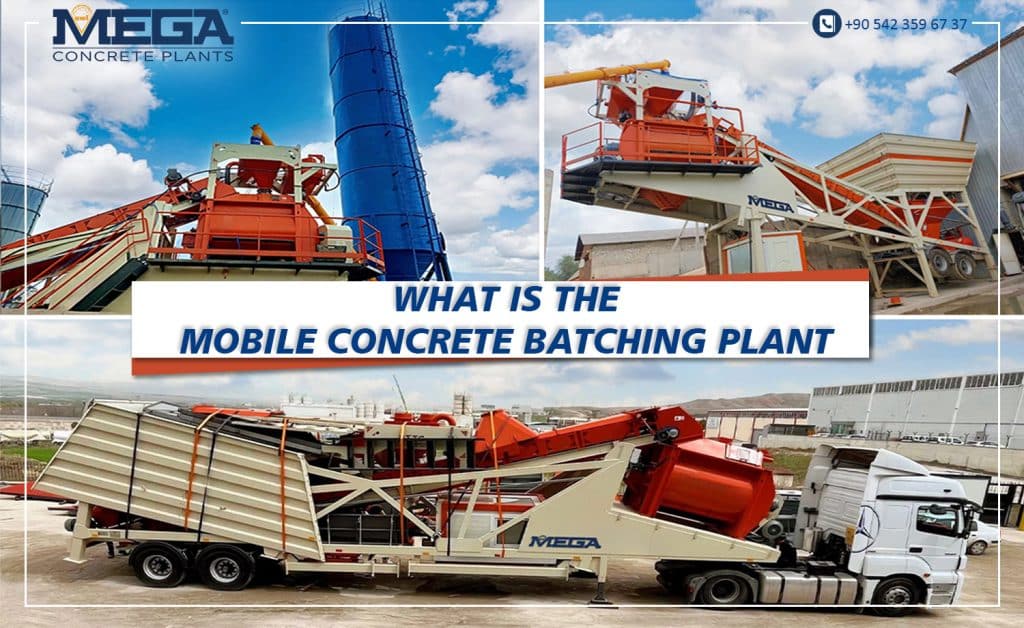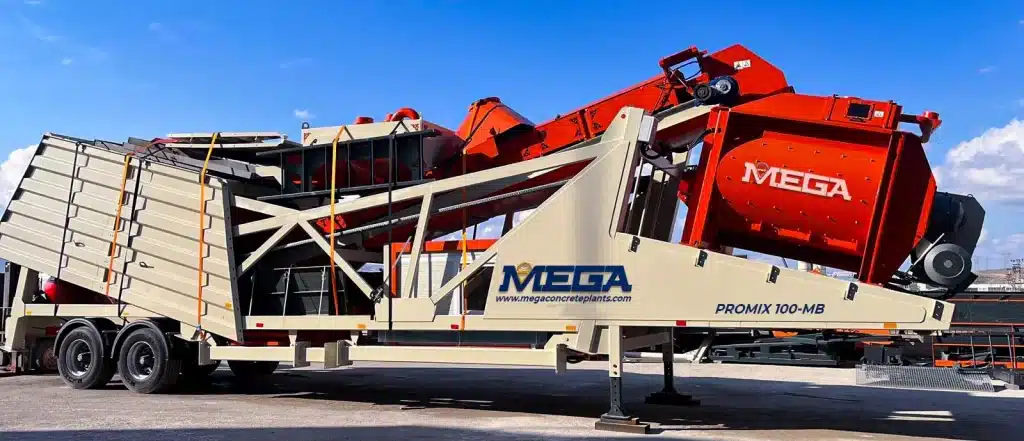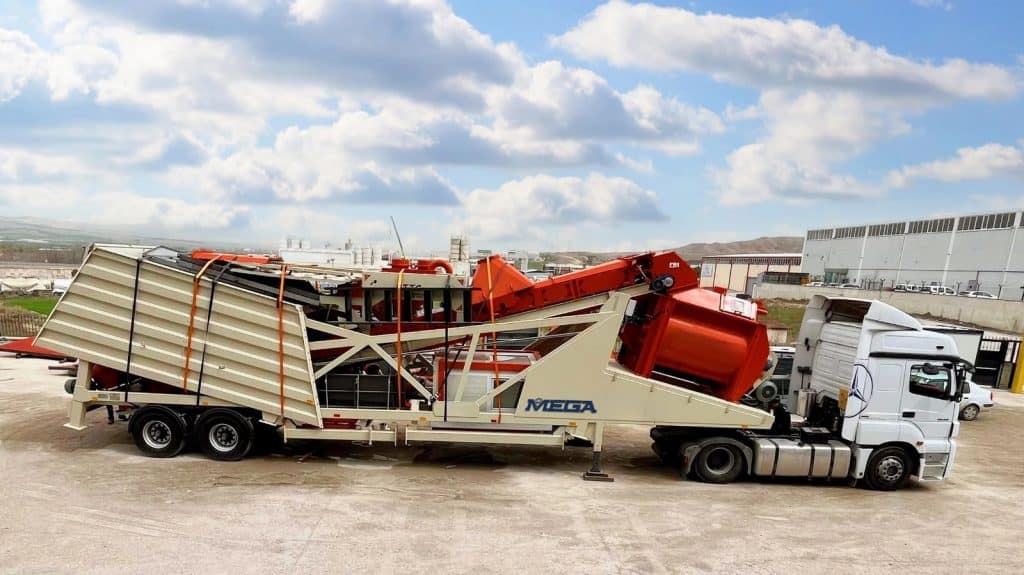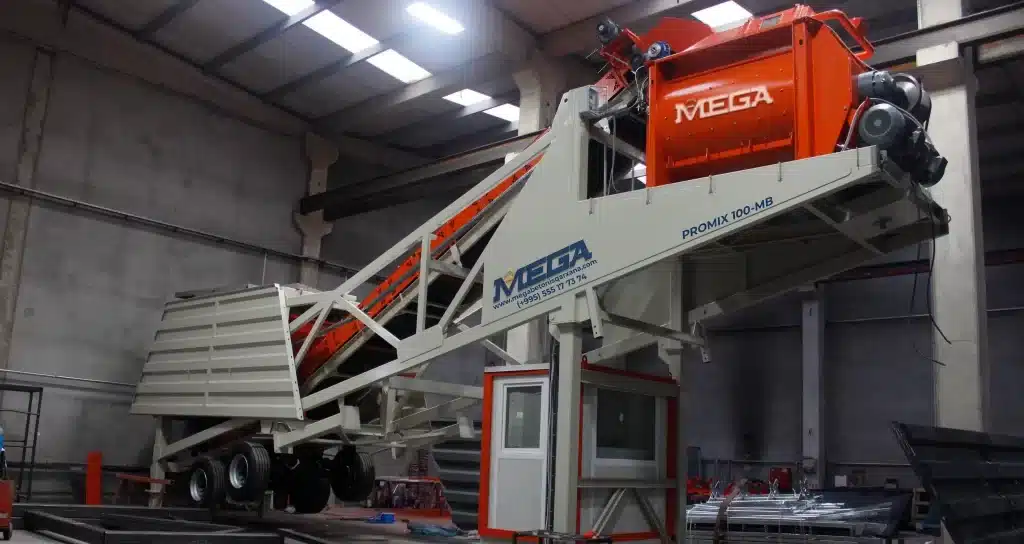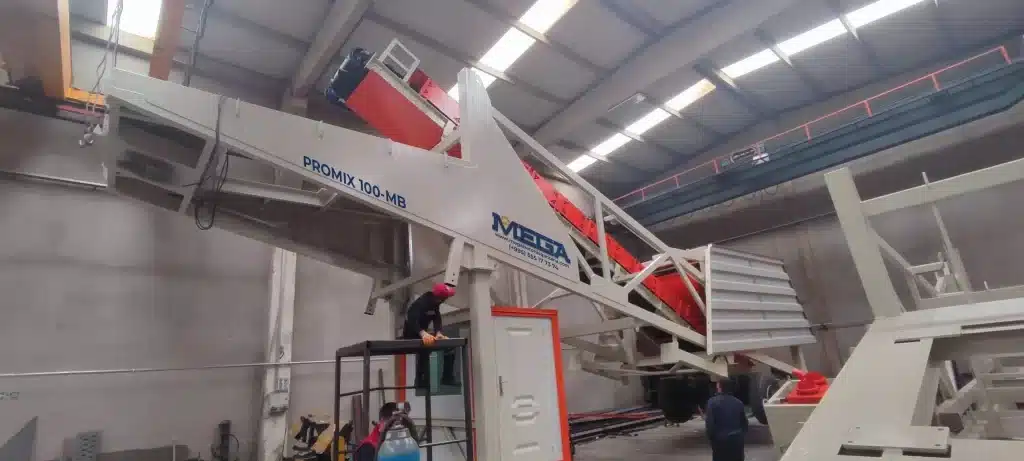Understanding The Mobile Concrete Batching Plant
A mobile concrete plant, also known as a portable concrete batching plant, is a facility that combines various ingredients to form concrete. These ingredients typically include water, air, cement, aggregates (such as sand, gravel, or crushed stone), and admixtures (chemicals added to alter the properties of the concrete). Unlike stationary plants, mobile concrete plants are designed to be easily transported to different locations, providing flexibility and efficiency to construction projects.
A mobile concrete batching plant is a specialized type of equipment used in construction for mixing and batching concrete on-site.
Unlike stationary concrete plants, which are set up at a fixed location, mobile concrete batching plants are designed to be easily transportable and can be quickly assembled and disassembled at different project sites.
In the dynamic world of construction, efficiency and mobility are paramount.
Mega Concrete Plants stand out as indispensable assets, offering unparalleled flexibility and convenience in concrete production.
In this blog post, we’ll explore the key features and benefits of these versatile plants and how they contribute to seamless construction operations. What kind of components are used for it? What are their advantages and disadvantages? How they are transported from site to site?
Production Capacity
The production capacity of a mobile concrete plant refers to the amount of concrete it can produce in a given time frame, typically measured in cubic meters per hour (m³/hr).
A plant with a capacity of 100 m³/hr means it can produce 100 cubic meters of concrete every hour, ensuring a steady and reliable supply for large-scale projects. This level of output is ideal for infrastructure projects, commercial developments, and residential buildings, reducing downtime and speeding up construction timelines.
Types of Mobile Concrete Plants
- Dry Mix Mobile Plant: In this type, all the ingredients except water are mixed together in a dry form. Water is added separately during transportation to the construction site or directly at the site.
- Wet Mix Mobile Plant: Here, all the ingredients, including water, are mixed together in the plant. This type generally provides a more homogeneous mix and is suitable for high-quality concrete production.
Main Structure of Mobile Concrete Batching Plant
These plants typically consist of several components that have similarities with stationary concrete batching plants, including:
Aggregate Bins: Storage bins for storing different sizes of aggregates (such as sand, gravel, and crushed stone) used in concrete production.
- Different capacities have different Aggregate hopper capacities; 60m³ mobile concrete plants have 4x9m³ total 36m³ aggregate hopper volume. Able to use 4 different aggregates.
We provide extensive solutions to our customers, for different types and capacity aggregate hoppers contact us.
Conveyor Belts: Conveyor belts are used to transfer aggregates from the storage bins to the mixer.
- Longer conveyor belts need much more powerful electricity motors and the necessary configuration to initiate movement. Otherwise, the conveyor belt’s electricity engines are not able to be used for a long time of period. 2 types of conveyor belt have been used in mobile concrete plants. One of the conveyor belts is for weighing the aggregates and the other is for transferring the aggregates to the mortar mixer.
Cement Silo: A storage container for cement powder, which is used as a binder in concrete production.
Mixer: The heart of the batching plant, where aggregates, cement, water, and other additives are mixed to produce concrete.
- The twin-shaft mixer is used in these mobile plants to get a better amount of concrete with more homogenous concrete mixtures.
Control System: An integrated control system to monitor and regulate the batching process, including the mixing time, water content, and other parameters.
Advantages Of Mobile Concrete Plants
Mobile concrete batching plants offer several advantages, including flexibility, mobility, and cost-effectiveness. They are particularly useful for construction projects that require concrete to be produced on-site, such as road construction, building foundations, and infrastructure projects in remote locations.
While mobile concrete batching plants offer numerous advantages, such as flexibility, mobility, and efficiency, there are also some disadvantages to consider:
Limited Production Capacity: Mobile concrete plants typically have smaller production capacities compared to their stationary counterparts. This limitation may not be suitable for large-scale construction projects requiring high volumes of concrete.
Higher Initial Investment: The initial cost of acquiring a mobile concrete batching plant, especially one with advanced features and mobility options, can be higher compared to stationary plants. This initial investment may be a deterrent for some construction companies with budget constraints. The investment becomes more sense for long period usages like stationary concrete plants.
WE PROVIDE PRICE-PERFORMANCE PRODUCTS.
Dependency on Transportation: Mobile batching plants rely on transportation to move between project sites. This dependency on trucks or trailers for transportation can introduce logistical challenges, especially in areas with limited access or rough terrain.
MOBILE PLANTS WHICH HAVE CHASSIS WITH AXILE AND TIRES ARE MORE SUITABLE FOR TRANSPORTATION WHEN CONSIDER LOGISTICAL CHALLENGES.
Setup and Dismantling Time: While mobile plants are designed for easy setup and dismantling, this process still requires time and labor. Construction teams need to allocate resources for assembling the plant at each new site, which can impact project schedules and timelines.
Less Stability and Durability: Mobile concrete plants may have less stability and durability compared to stationary plants due to their portable nature. Factors such as frequent movement, exposure to harsh weather conditions, and rough handling during transportation can contribute to wear and tear over time.
WE PROVIDE 3 YEARS WARRANTY TO OUR PLANTS.
Space Limitations: Mobile batching plants require adequate space for setup and operation. In congested or confined construction sites, finding suitable space for deploying the plant may pose challenges and limit its effectiveness.
Potential Maintenance Issues: The mobility and portability of mobile concrete plants can make maintenance and servicing more complex. Components such as wheels, axles, and towing mechanisms may require regular inspection and upkeep to ensure optimal performance.
YOU CAN EASILY FIND ALL SEPARE PARTS OF OUR PRODUCTS ANYWHERE IN THE WORLD.
Environmental Impact: While mobile plants offer environmental benefits such as reduced transportation emissions, their operation still contributes to noise pollution and disturbance at construction sites. Proper planning and mitigation measures are necessary to minimize the environmental impact of mobile batching plants.
Despite these disadvantages, mobile concrete batching plants remain a valuable asset for construction projects requiring on-site concrete production and flexibility. By carefully assessing project requirements and weighing the pros and cons, construction companies can determine whether a mobile plant is the right fit for their needs.
WE AS MEGA CONCRETE PLANTS HERE TO ENLIGHT YOUR QUESTIONS.
How To Move The Mobile Batching Plants?
Mobile concrete batching plants are designed for easy transportation between different project sites. There are several ways these plants can be moved:
Towable Trailer: Many mobile concrete batching plants are mounted on trailers with wheels, making them towable by a truck or other suitable vehicle. This design allows for easy transportation on roads and highways to different project locations. Once at the site, the trailer can be stabilized and leveled for operation.
On-Site Mobility: Some mobile batching plants are equipped with built-in axles and wheels, allowing them to be moved around the site using a towing vehicle or by manually pushing and pulling. This on-site mobility enables flexibility in positioning the plant closer to the construction area or optimizing space utilization.
Containerized Design: Certain mobile concrete batching plants are designed to be containerized, meaning they are housed within standard shipping containers. These containerized plants can be transported via truck, rail, or ship to different locations, offering greater mobility and versatility for international or remote projects.
Modular Construction: Modular mobile batching plants are assembled from prefabricated modules, which can be easily transported and assembled at the desired site. This modular construction allows for quick setup and dismantling, making it ideal for temporary or mobile construction projects.
Overall, the mobility of mobile concrete batching plants is achieved through innovative design features such as wheels, trailers, containerization, and modular construction, enabling them to be transported and deployed efficiently to various construction sites as needed.
What should be considered while purchasing a mobile concrete batching plant?
These considerations are mentioned also in our previous blog which I highly recommend you read about it for stationary concrete plants.
Production Capacity: Determine the required production capacity of the plant based on your project’s needs.
WE HAVE VARIOUS MODELS FOR MOBILE CONCRETE PLANTS WHICH HAVE DIFFERENT CONCRETE PRODUCTION CAPACITIES :
- PROMIX 30-MB, 30 m3 concrete production per hour.
- PROMIX 60-MB
- PROMIX 100-MB
- PROMIX 120-MB
Mobility and Transportability: Evaluate the plant’s mobility features, including its ease of transportation, setup, and dismantling. Consider factors such as size, weight, and the availability of towing options.
Quality of Components: Assess the quality and durability of the plant’s components, including the mixer, conveyor belts, aggregate bins, and control system. Opt for reputable brands known for reliability and longevity.
Mixing Performance: Consider the mixing performance and efficiency of the plant, including mixing time, homogeneity of the concrete mix, and ability to handle different types of aggregates and admixtures.
Batching Accuracy: Check the accuracy of the batching system in proportioning aggregates, cement, water, and additives. Accurate batching is crucial for producing high-quality concrete with consistent properties.
Environmental Considerations: Evaluate the environmental impact of the plant, including noise levels, emissions, and dust control measures. Choose a plant that complies with local environmental regulations.
Maintenance and Support: Consider the availability of spare parts, technical support, and after-sales service from the manufacturer or supplier. A reliable support network is essential for minimizing downtime and ensuring smooth operation.
Cost and Budget: Compare the initial purchase cost, installation expenses, and ongoing operational costs of different plant options. Balance upfront investment with long-term value and performance.
Customization Options: Determine if the plant can be customized to meet specific project requirements or if additional features and accessories are available as options.
User-Friendly Design: Look for a plant with a user-friendly design and intuitive control interface to simplify operation and maintenance tasks.
REACH US FOR EXTENSIVE SOLUTIONS

